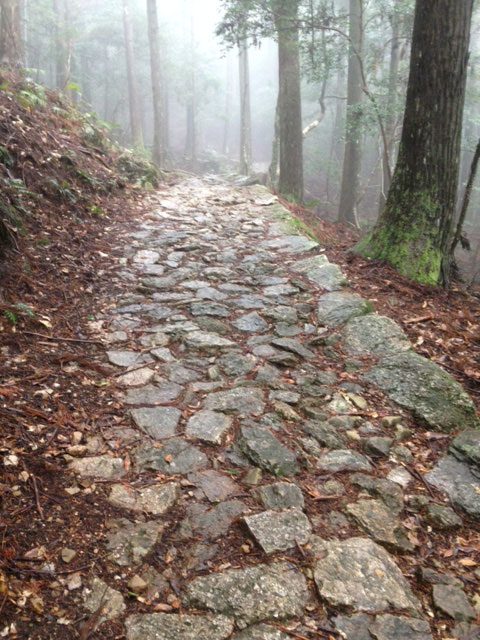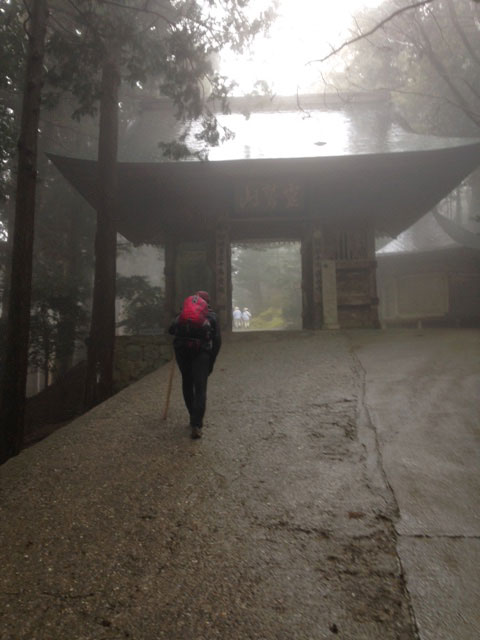Letters Home: A thousand-year-old walking trail, the 88 temples of Shikoku
We’ve been walking for six days now, at every corner looking for the trail sign, a pilgrim in a big straw hat. People who follow this ancient circular route of 1,100 kilometers around the island of Shikoku are called Henro, and we are doing our pilgrimage the traditional way, on foot.
Most of the other Henro we see are Japanese and as we pass each other we smile and say “Gambatte,” Good Luck. We are all following in the footsteps of a Japanese folk hero, Kobo Daishi, a monk who accomplished all sorts of amazing deeds. At one temple he dug a deep well overnight to help a village suffering from drought. In another temple he created a stone image of the Buddha using only his fingernails, and at the temple we will walk to today, temple number 22, he dug another well with his staff and a milky water came out that can cure many sicknesses, and bring good fortune. As well as these super-natural deeds Kobo Daishi invented a syllabic alphabet so the Japanese could have a written language. This all happened 1,500 years ago.
Today the Shikoku pilgrimage is a way to see a beautiful part of Japan along a route with mountain trails and city streets and narrow paths between rice fields. On our first full day of walking it rained and rained but at each temple we greeted other soggy Henro and along the way found two bakeries. We sat together on a bench in the second one wolfing down warm cream-filled pastries. The owner brought us all small cups of coffee, free for the Henro. The tradition of oseitai, giving pilgrims gifts, means that the giver will also receive a blessing. One day we acquired two bags of oranges and a bag of candy.
Tom and I are traveling with Jeanne and Mark, two friends who are as crazy as we are about long walks. They don’t know Japanese but smile and bow and the Japanese women love to remark on how tall Jeanne is, at 5’10” she towers over the petite Japanese older women.
We are all carrying packs with warm clothes and other essentials but no tents. At night we stay at minshuku, small family-run inns that serve traditional dinners and breakfasts. Each meal is a feast for the eyes as well as the palate with small dishes of pickles, fish, and vegetables arranged in beautiful ways. Miso soup, green tea, and white rice are a part of every meal. No Rice Krispies for breakfast here.
After our first day of rain we had better weather, though on the third day we climbed up and over three mountains and at the summits snow dusted the ground. The last temple soared above the valleys below and included a row of giant cedar trees, planted several hundred years ago. I was so happy to have gotten to the last summit that I gave the Kobo Daishi statue an extra big bow.
Yesterday it rained again and not just a gentle mist. I had learned after the first day of rain that my pack is NOT waterproof and so wrapped up everything inside the pack in plastic bags. We had a long day planned – three temples, two mountains, and about 17 miles of walking. We didn’t see any Henro at the first two temples. Were they all smarter than us and had decided to take the day off? At the second temple Mark found a little shop selling small sponge cakes and we each gulped one down, trying not to drip all over the floor. In another crowded shop I poked my head in and asked if the store sold tebukoro, gloves, as mine were soaking wet. The small old woman brought out stash of the white cotton gloves that farm workers wear. For 100 yen, less than a dollar, they were a warm deal.
The Henro trail is well signed and has public toilets along the way, a great idea for Henro who drink lots of green tea. Sometimes there are shelters and yesterday, a kind flag woman let us stop inside the construction office where she offered us oranges and more green tea. And we were thrilled to find a noodle shop after plodding along a busy road for a few wet miles. The steaming bowls of udon, a thick white noodle, revived our spirits and warmed us in and out.
Then we reached the mountain trail part of the day. Of course we had looked at our maps but somehow we had failed to realize we would hike a couple of miles almost straight up to the next temple, a lovely place with statues of Japanese cranes. And we had also under-estimated the time it would take to get to the last two temples. It would now be an epic push to go down one mountain and up the next to catch the last tram of the day down to the bottom, where we had reserved a room for the night.
Fortunately as we stepped down the first steep mountain, the rain slowed down. And in the valley at the bottom plum trees bloomed in old terraces made of intricately placed stones. We crossed an emerald blue river on a narrow bridge and started up the other side, following a bright little stream that could have been in the Adirondacks. As I forced my tired legs to go faster I admired little waterfalls and deep swimming hole pools.
Up and up and up. The trail became an endless series of steps. The other three had disappeared ahead and I was left alone in the dark woods with a strong, cold wind. Japan is a country of contrasts and I knew that the little wilderness I walked through would end at an ancient temple with a modern cable car to take us down to a village below.
But the strong wind changed our plans and as I arrived at the temple at 4:50 p.m., I learned from Mark that the tram was closed due to the wind. We ended our long day packed into a van that careened down the mountain on a narrow, windy road. One of the Japanese Henro in the back said we needed Kobo Daishi to protect us now. We all laughed, but I remembered the kind face on the statue above us and the many feet who had walked this way before us.












Thanks for the report. Due to my father’s time spent in Japan, prior to and during the Korean War and his knowledge of the language that the smidgen of awareness I have of Japan is stimulated by a story like this.
Hi Jeff,
Thanks for your thumbs up on my first Japan post. We’ve now been walking for two weeks and every day is an adventure. Today we walked with a seventy-year-old Englishman and his friends’ son, a twelve-year-old Japanese boy. We visited three temples and crossed city streets as well as rice fields. This part of Shikoku is famous for nasu, eggplant, and we passed many greenhouses filled with lush plants.
I will write another Japan post tonight and I think it will be posts within a week.
O genki de,
Stay Healthy,
Betsy
Thank you for sharing, Betsy! It made me want to follow your steps! I look forward to your next post—-Safe journeys and many wonderful memories to you and Tom!
Was so awesome to read and see pics. Thanks for sharing. God willing, I would like to do this pilgrimage some day.
Dear Ginger and Rajiv,
Good to hear from you both! It is evening here and all the guests in this little inn are wearing yukata, the thin cotton kimono to wear after a hot bath. Traditionally guests bathe before dinner and wear their yukata to the meal.
Today we visited three temples. Temple 31 was surrounded by a huge botanical park. What a treat to walk past so many beautiful trees and flowers, and then through a tropical green house. Temple 32 was on top of a big hill with long stone steps and a great view of Kochi city and the ocean. And to get to temple 33 we took a short, free ferry and walked a kilometer to the temple. Tomorrow our route will take us back to the ocean.
It is such a special journey, to walk on this ancient route and see this beautiful land. I will be posting another blog soon.
Betsy
You write so well, It feels I am there
Thanks for sharing your insights and photos!
Gambatte for the rest of your pilgrimage Betsy and Tom❤️
Thanks to both Betsy and Ginger for sharing. I am going to send this on to some monk friends in PA and a haiku poet friend in Chicago. Lovely pictures and words.
Anne B